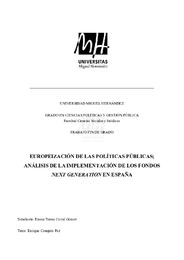Por favor, use este identificador para citar o enlazar este ítem:
https://hdl.handle.net/11000/32582Registro completo de metadatos
| Campo DC | Valor | Lengua/Idioma |
|---|---|---|
| dc.contributor.advisor | Conejero Paz, Enrique | - |
| dc.contributor.author | Corral Gómez, Emma Teresa | - |
| dc.contributor.other | Departamentos de la UMH::Ciencias Sociales y Humanas | es_ES |
| dc.date.accessioned | 2024-07-22T08:41:57Z | - |
| dc.date.available | 2024-07-22T08:41:57Z | - |
| dc.date.created | 2024-06 | - |
| dc.identifier.uri | https://hdl.handle.net/11000/32582 | - |
| dc.description.abstract | El COVID-19 supuso una gran desestabilización para todos los países a nivel mundial, y los países Europeos no fueron la excepción. Como respuesta, la Unión Europea ha desplegado un ambicioso plan para la recuperación post-COVID, los conocidos como Fondos Next Generation EU, que actualmente ascienden a 750 mil millones de euros. Los Fondos están diseñados para apoyar a todos los países miembros en la superación de los impactos tanto económicos como sociales post pandemia, impulsando la inversión económica en áreas clave como Sanidad, Pymes, Industria o Digitalización, entre muchas otras. En el presente trabajo se analizará la implementación de los Fondos Europeos en España, tanto a nivel jurídico en su transposición de legislación como a nivel de eficiencia y eficacia en la sociedad. Tratando conceptos de Políticas Públicas tales como el Enfoque Top Down. Atendiendo siempre al impacto que han podido tener dichos fondos, impulsando innovación, ayudas y sostenibilidad a nivel regional y nacional. Todo ello habiendo explicado el contexto de su proposición y aprobación en las diferentes instituciones de la Unión Europea. Al final, tanto la implementación como la gestión eficiente de los Next Generation será crucial para maximizar su nivel de impacto, a corto y largo plazo, en los diferentes países de la Unión Europea y en especial en el nuestro, puesto que España encabeza la lista de beneficiarios. | es_ES |
| dc.description.abstract | COVID-19 was a great destabilization for all countries worldwide, and European countries were no exception. In response, the European Union has deployed an ambitious plan for post-COVID recovery, known as Next Generation EU Funds, which currently amount to 750 billion euros. The Funds are designed to support all member countries in overcoming both the economic and social impacts of the post-pandemic, promoting economic investment in key areas such as Health, SMEs, Industry or Digitalization among many others. In this work, the implementation of the European Funds in Spain will be analyzed, both at a legal level in its transposition of legislation and at the level of efficiency and effectiveness in society. Dealing with Public Policy concepts such as the Top Down Approach. Always considering the impact that these funds may have had, promoting innovation, aid and sustainability at the regional and national level. All this having explained the context of its proposal and approval in the different institutions of the European Union. In the end, both the implementation and efficient management of Next Generation will be crucial to maximize their level of impact, in the short and long term, in the different countries of the European Union and especially in ours, since Spain heads the list of beneficiaries. | es_ES |
| dc.format | application/pdf | es_ES |
| dc.format.extent | 63 | es_ES |
| dc.language.iso | spa | es_ES |
| dc.publisher | Universidad Miguel Hernández de Elche | es_ES |
| dc.rights | info:eu-repo/semantics/openAccess | es_ES |
| dc.rights.uri | http://creativecommons.org/licenses/by-nc-nd/4.0/ | * |
| dc.subject | Plan de Recuperación | es_ES |
| dc.subject | Enfoque Top Down | es_ES |
| dc.subject | Inversión Pública | es_ES |
| dc.subject.other | CDU::3 - Ciencias sociales::32 - Política | es_ES |
| dc.title | Europeización de las políticas públicas; análisis de la implementación de los fondos next generation en España | es_ES |
| dc.type | info:eu-repo/semantics/bachelorThesis | es_ES |

Ver/Abrir:
TFG CCPP Corral Gomez Emma Teresa.pdf
610,95 kB
Adobe PDF
Compartir:
 La licencia se describe como: Atribución-NonComercial-NoDerivada 4.0 Internacional.
La licencia se describe como: Atribución-NonComercial-NoDerivada 4.0 Internacional.
.png)